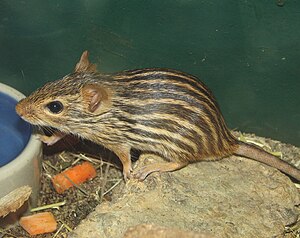Striped grass mice
| Striped grass mice | ||||||||||||
|---|---|---|---|---|---|---|---|---|---|---|---|---|

Berber striped grass mouse ( Lemniscomys barbarus ) |
||||||||||||
| Systematics | ||||||||||||
|
||||||||||||
| Scientific name | ||||||||||||
| Lemniscomys | ||||||||||||
| Trouessart , 1881 |

The striped grass mice ( Lemniscomys ) are a genus of rodents from the group of old world mice (Murinae).
features
Striped grass mice reach a head body length of 8 to 14 centimeters, in addition there is an 8 to 16 centimeter long tail. Their weight varies between 18 and 68 grams. Their rough fur is dark gray to dark brown in color on the upper side, the underside is whitish to light gray. Within the genus three different forms of the striations may occur: In case of the single strip grass mouse ( Lemniscomys rosalia ) is merely a dark Aalstrich present in some other species, including the typical striped grass mouse ( Lemniscomys striatus ) are located in rows arranged bright spots that sometimes streaks are grown together. The Barbary striped grass mouse finally has a plurality of solid, bright longitudinal stripes appear on her back.
Distribution and way of life
Striped grass mice are distributed all over Africa , their range extends from Morocco to South Africa . Depending on the species, they inhabit different habitats, from savannas and steppes to grasslands and forest clearings. They build spherical nests from leaves and grass that are hung in tall grass or in low shrubs. They do not dig burrows, but when in danger they often flee into earth passages created by other animals. The food is grass and seeds, and sometimes insects. They are predominantly diurnal, but there are also reports of twilight or night activity of individual species.
Grass mice live rather solitary. The potential life expectancy is four to five years, but this age is unlikely to ever be reached in the wild. Due to the large number of enemies and the way of life above ground, almost all grass mice die before they are one year old. Accordingly, striped grass mice are very reproductive. A litter includes one to twelve young; is thrown during the rainy seasons, which in East Africa lasts from April to June and from September to December. In these periods there can be several litters; one captive couple raised four litters in just 15 weeks.
Systematics and risk
Wilson and Reeder (2005) list the following eleven types:
- The real striped grass mouse ( Lemniscomys striatus ), also known as the spotted grass mouse, inhabits savannas in almost all of Africa south of the Sahara.
- The Griselda striped grass mouse ( Lemniscomys griselda ) lives in Angola and neighboring areas.
- The Senegal single- striped grass mouse ( Lemniscomys linulus ) lives in forest clearings from Senegal to the Ivory Coast.
- The single-striped grass mouse ( Lemniscomys rosalia ) is widespread from Kenya to South Africa.
- The Rosevear Strip grass mouse ( Lemniscomys roseveari ) is only known from two locations in Zambia.
- The Buffoon striped grass mouse ( Lemniscomys macculus ) occurs from southern Sudan to the east of the Democratic Republic of the Congo.
- The Berber striped grass mouse ( Lemniscomys barbarus ) lives in northern Africa from Morocco to Tunisia.
- The Heuglin striped grass mouse ( Lemniscomys zebra ) lives south of the Sahara in a strip from Senegal to Tanzania. Sometimes it is combined into one species with the Berber striped grass mouse.
- The Bellier striped grass mouse ( Lemniscomys bellieri ) lives in dry savannahs in western Africa.
- The Mittendorf striped grass mouse ( Lemniscomys mittendorfi ) only lives on the shores of Lake Oku in Cameroon.
- The Hoogstraal striped grass mouse ( Lemniscomys hoogstraali ) is only known from one specimen that was found in 1961 on the banks of the Nile in Sudan.
The IUCN lists the Mittendorf-strip of grass mouse as "at risk" ( vulnerable ) for which Rosevear Strip grass mouse and Hoogstraal Strip grass mouse are available too little data ( data deficient ). The other eight species are considered “not endangered” ( least concern ).
The striped grass mice are systematically classified within the old world mice in the Arvicanthis group .
literature
- Ronald M. Nowak: Walker's Mammals of the World. 2 volumes. 6th edition. Johns Hopkins University Press, Baltimore MD et al. 1999, ISBN 0-8018-5789-9 .
- Don E. Wilson , DeeAnn M. Reeder (Eds.): Mammal Species of the World. A taxonomic and geographic Reference. 2 volumes. 3. Edition. Johns Hopkins University Press, Baltimore MD 2005, ISBN 0-8018-8221-4 .
Web links
- Lemniscomys on the IUCN Red List of Threatened Species. Retrieved October 6, 2009.